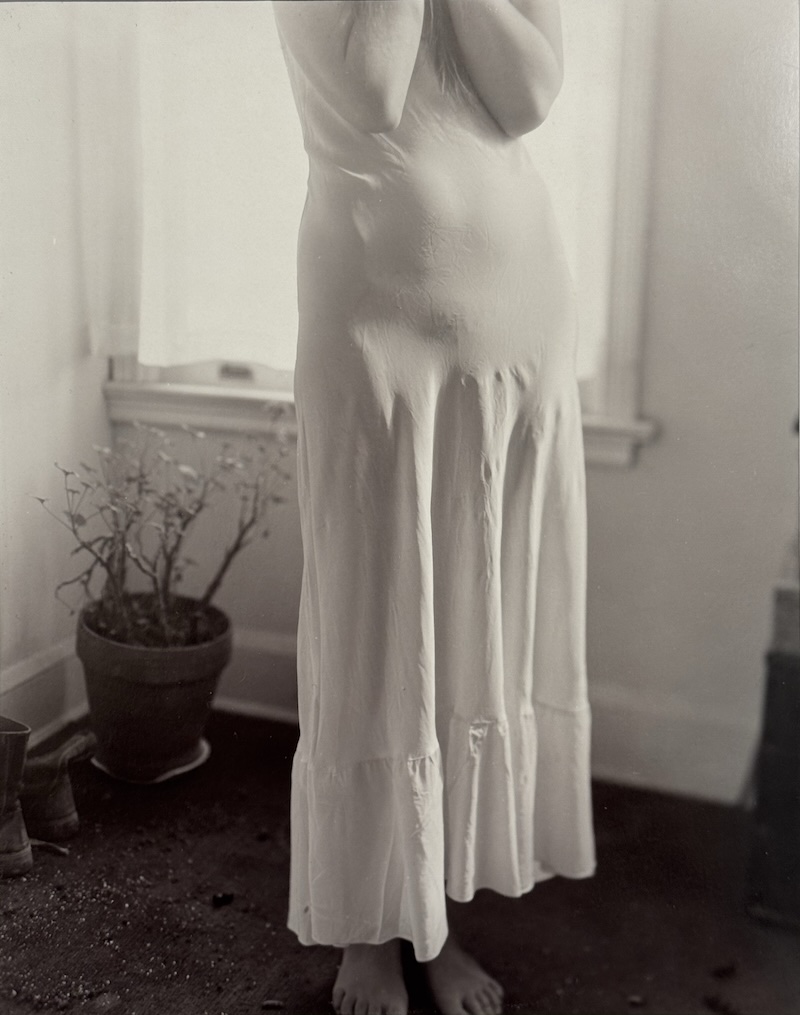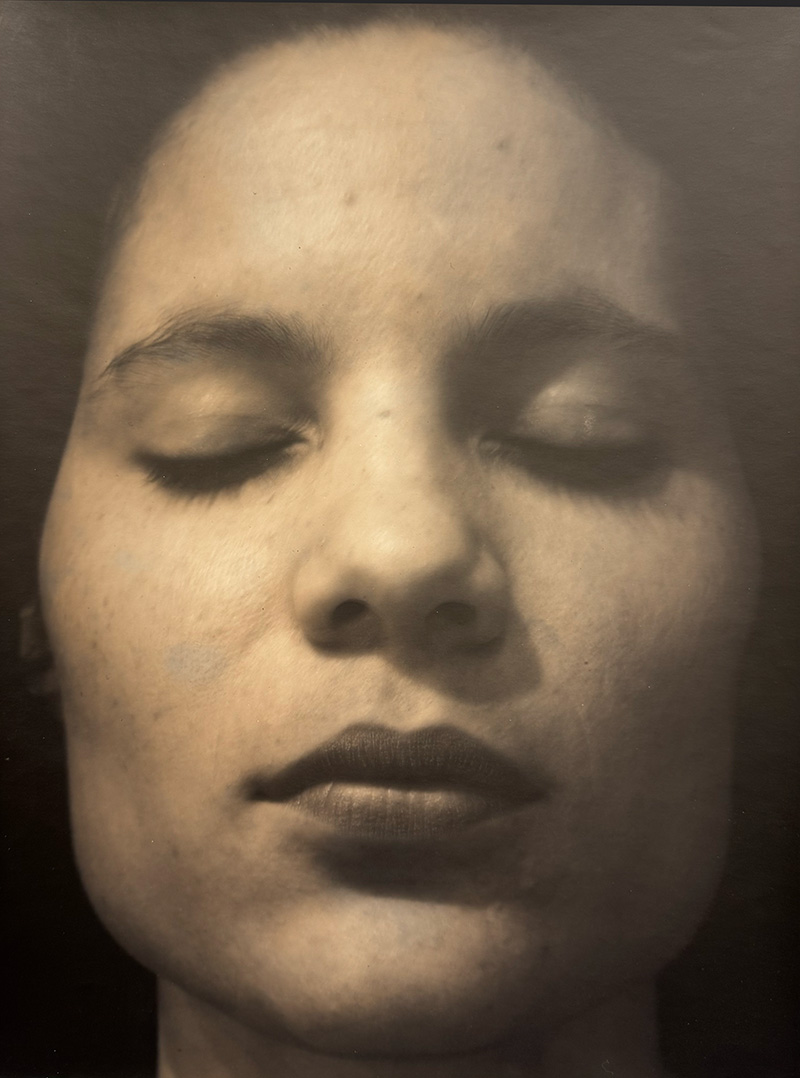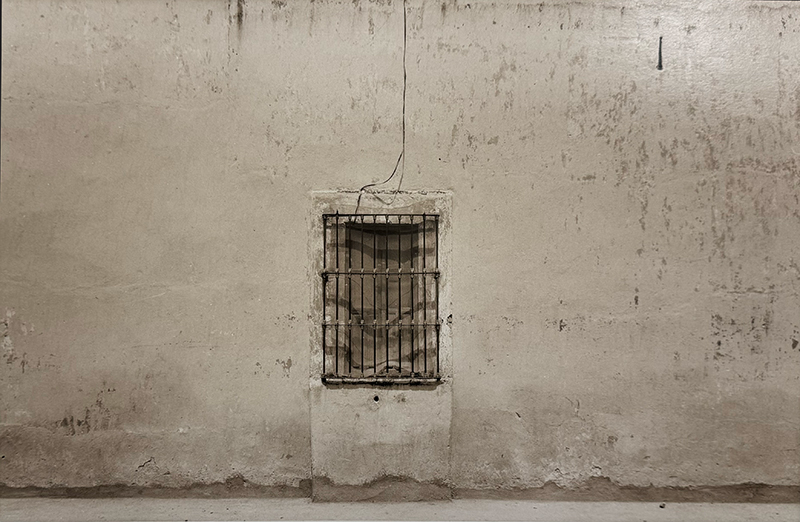Recent Donation of Mark L. Power ’59 Photographs
By Bowdoin College Museum of Art
Earlier this summer, Virginia Power of Chesapeake, Maryland, presented the Museum of Art with a generous gift of 18 photographs by her late husband Mark L. Power ’59 (1937–2020). These are the first photographs by Power to enter the Museum’s collection. One of the most influential late 20th century fine art photographers in Washington, D.C., Power was also a legendary teacher. Beginning in 1971, along with Joe Cameron and later Frank DiPerna, he built the photography program at the Corcoran College of Art and Design into the leading school in the region. He also helped to organize photography exhibitions in Washington, first at Icon Gallery and later at the Corcoran.
As Virginia explains in the interview below, Power’s photography is not easily categorized. He created portraits, landscapes, and narratives that combined text and image. That said, in everything he did he displayed a lifelong commitment to innovation and technical excellence. His photographs were highly original, deeply conceptualized, and beautifully printed. We are very grateful for this generous gift.
In early July, Frank Goodyear spoke with Virginia spoke about Mark Power’s life and work. Below are excerpts from that interview. The interview has been edited for clarity.

Frank Goodyear (FG): I wonder if we could start at the beginning with Mark’s early education. I know he grew up in Washington, D.C., in the Virginia area. How did he end up going to Bowdoin? Did he have a good experience here?
Virginia Power (VP): He went to Portsmouth Priory in Rhode Island. It was a boarding school, and he graduated from high school there. I do not know why he chose Bowdoin; perhaps because friends from Portsmouth Priory were going there.
FG: Was he a good student? Do you know what he majored in?
VP: I don't think he was a particularly good student. However, I'd like to say that I don't believe that Mark was cut out for college. He liked it there, and I think he would have stayed had it not been for the fact that he thought he was going to be drafted into the U. S. Army. At the time, the Korean conflict was beginning to build, so he decided to leave Bowdoin after a year to join the Army.
FG: Did he go back to school after his service?
VP: He served in the Army from 1957 to 1960. Following his military service, I believe he attended the Arts Center School in Los Angeles for about a year. In 1961, he moved back to Washington and enrolled at American University.
FG: Do you have a sense of when he first started making photographs? Was this something that he pursued as a child? Is it something that he discovered in school or after college?
VP: He discovered photography while he was in the Army, partially because he met George Krause, who had also joined up. I’m not sure what duties they were assigned, but they were both in the same unit, and they connected. George was a huge influence on Mark at that point in terms of photography. He knew a great deal about art history and was already taking photographs. Their friendship endured for years after they both left the Army, and they remained friends until Mark died in 2020. I’m still in touch with George, who is now in his late eighties. He visited us at the farm and took many trips with Mark to Mexico and Spain, where they would constantly take photographs. George also came to England while we were living there, and Mark organized a show for him at a gallery in Norwich, England. George shared Mark’s love of photography and appeared in many of Mark’s photographs.
FG: What kind of photographs was he making when he first started taking pictures? Did he gravitate towards a particular genre? Did he see himself as a fine art photographer or a documentarian? How do you characterize his early years in photography?
VP: He began taking photographs of family and friends, primarily of his family. He took many pictures of his father and mother on their farm in Virginia. The same farm served as the backdrop for many of his early photographs. I think he always saw himself as a fine art photographer. This was before he started the Icon Gallery of Washington in 1968.
FG: Did you get a sense of what Mark wanted to do professionally after he left the Army? Why did he come back to Washington to make a life?
VP: I think he came back to Washington because of his family. It was his staging point always. At a very young age, he lived with his family near Dupont Circle. The Washington area was where he grew up, and he came back to it, like a lot of us do. Then it was simply a matter of what he would do next. His father partially supported him financially to open the Icon Gallery with Charlie Tompkins. That was a major step forward in terms of showing other people’s art, which he really wanted to do. He wanted to bring fine art photography to Washington. It wasn’t there in 1968. He kept the gallery going by doing freelance work simultaneously. I'm not sure exactly what form that took, but it might have included weddings or taking portraits of people to support himself financially.
FG: In terms of building a photography program at the Corcoran, was that decision to get involved in teaching also inspired by a desire to raise photography's profile in the region?
VP: It started because he had a friend, Jerry Lake, who was teaching photography at the Corcoran. Jerry took Mark on as an assistant. They worked together teaching photography before any particular curriculum was established. When Jerry left, Mark took it over. It was then that he began to build a substantial photography program. He hired Joe Cameron and Frank DiPerna, and they all agreed that they needed to build an accredited program at the Corcoran. Eventually, it was a fully-fledged program and attracted a great many talented photographers.
FG: You had not met Mark at this point. You arrived a little bit later on the scene. Am I correct?
VP: No, actually, I met Mark in 1968. I had a close friend at that time who was also a photographer, who experimented with very bold hand-colored work. We went to the Icon Gallery one day, where we met Mark, who then wanted to give him a show. That was my first introduction to Mark.
FG: As an educator at the Corcoran, were there certain recurrent lessons that he imparted to his students?
VP: In the darkroom, he was a master printer. That, in itself, was a lesson to them: how to print as best they could. But more importantly, at least to me, was Mark’s wonderful, unassuming approach to students. He wasn’t the traditional teacher who said, “I think you should change this in your photograph,” or “I think you should make this more prominent.” Instead, he asked them to express their feelings about their photographs. He preferred to give them the option to discuss their photographs rather than instructing them to approach the work in a different way. He made them feel comfortable and in control of their work in a quiet, unassuming way. He was an extraordinary teacher that way. He devoted his time not only to reviewing their work before discussing it, but he also gave them one-on-one attention.
FG: I understand what you’re saying, and you’ve described it quite beautifully. There is a nurturing of a relationship and seeing the student as a human being who’s grappling with similar issues. It’s more than simply learning to develop work in a darkroom. Photography is a way we engage with the world, and my sense is that Mark wanted to have a conversation with students on that level. Let’s talk about Mark's own photography. In looking at pictures with you and reading more about Mark's career, I find it difficult to pigeonhole him in one photographic genre. It strikes me that he created a great variety of different photographic projects. I wonder how you would characterize the kind of photographer he was.
VP: This is a particularly interesting question because Mark created numerous series, many of which were quite distinct. It’s hard for me to say what went through his mind, but he had an amazing imagination and was very creative. He was constantly moving forward, thinking about different themes. He didn’t generally plan out exactly what he wanted to do, but when he started looking at a group of photographs, he began to assemble themes. I think that’s how he approached a lot of his series. Mark was somebody who never went anywhere without a camera. He was always taking photographs. He took up photography because he loved creating pictures. It was his whole life. If the photographs were recognized and shown, and he was acknowledged, that would please him. But that was not the reason behind his work.
FG: That’s very helpful. I gravitate to the Rita Hayworth series because I find it so wonderfully original and innovative. The idea of using photography to tell a story, to imagine the life of a celebrity, to use models and set them in a particular place, and to fashion the whole scene, I think it’s all wonderfully compelling.
VP: I know what you mean. I agree. The Rita Hayworth series was adapted into a book, but the photographs stand out individually. We worked together on that project because I was the model for so many of them. I began to understand what he wanted from these photographs. His daughters, Rachel and Shelagh, also played a significant role in the Rita Hayworth photographs, as well as many of his other series.
FG: Did he give you direction?
VP: Our exchange was always informal. I might be in the garden sunbathing, and he would come over with his camera, and he might say, “Can you move your head a little bit that way?” or “Can you turn your body to face the catalpa tree?” It was very relaxed.
FG: How important to Mark was it that the narrative he was creating in his photographs matched the actual life of Rita Hayworth?
VP: I think he took quite a bit of license with her story. However, he correctly listed dates and the names of her parents and various husbands.
FG: Mark did a lot of work out at your family farm in Virginia. What was it about the farm that resonated with him as an artist? Was it the memories of family, the history of that place, the land itself?
VP: Yes, the history of the place, indeed the beauty of the place. There were magical things about the farm. This connection to his childhood, home, and family memories led him to revisit those memories and take photographs there. He was very close to his father, and I think his father’s death shook him. Certain things in the house reminded him of his father, so he created these memories in his photographs, sometimes mystical ones. His father was an architect by trade but became a writer and painter who moved with Mark’s mother to the farm in the 1930s. I recall the wonderful murals he painted on many of the house’s walls. I remember him always being supportive of Mark’s interests.
FG: One final question. Do you have a sense of how Mark would want to be remembered?
VP: This is a hard question. I called two of his daughters last night: Shelagh first and then Rachel. They were both very close to him. Both said that he would like to be remembered as a writer and an innovative photographer who never stopped working and believed deeply in artistic expression. He was also a person who defended the right to express oneself. He fought against censorship, most famously during the controversy surrounding a Corcoran exhibition of photographs by Robert Mapplethorpe, which conservative members of Congress sought to shut down. He took a leading role in writing about this issue. It was huge for him. I think he would want to be remembered as a teacher. I don’t know whether he set out in life to become a teacher, but he became incredibly good at working with students. At his memorial photography show at Glen Echo, I was so struck by the many students who came up to me or later wrote to me, sharing the profound impression Mark had made on them. He should be remembered for his generosity of spirit and his wry sense of humor. I miss him terribly. He had an enormous impact on my life. He was such a lovely human being on so many levels.
